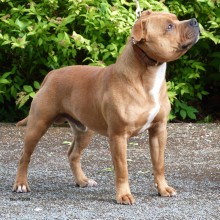Staffordshire Bull Terrier
Lifestyle Needs

The Staffordshire Bull Terrier or ‘Stafford’ is a popular small sized pet dog who is very happy to be a family member. He is known for his strength and courage and utter devotion to his family. Some Staffords do not socialise well with other dogs, so need firm handling when out and about. Generally if treated well and given appropriate early socialisation and training the Stafford will behave well and reward his owner with excellent behaviour. He needs at least an hour’s exercise every day and opportunities where he can meet other people and dogs.
Genetic Diversity
(Known as Coefficient of Inbreeding: 'COI'. It should be as low as possible.)
The UK Kennel Club breed average COI is 7.6% - See 'A Beginners Guide to COI'
Gene Pool Size
(Known as Effective Population Size: 'EPS')
97.7
EPS is a measure of how many individuals are contributing genetically to a breed population. It is a measure of the size of the gene pool in a breed. Lower than 100 is considered critical by conservationists and below 50 brings a breed close to extinction. For more information see the Kennel Club article.
Health and Welfare Problems due to Conformation
(Body shape and physical characteristics)
- Brachycephalic Obstructive Airway Syndrome (BOAS) due to shortened skull
BVA/KC Health Schemes: www.bva.co.uk/chs
- Hip dysplasia: breed 5 year mean score 16.8 (parents should be lower)
- Elbow dysplasia: score should be as low as possible ideally 0:0
- Eye disease
Litters should also be screened for PHPV
Estimated Breeding Values (EBVs) : No EBVs are currently available for this breed
www.thekennelclub.org.uk/about-ebvs
DNA Tests Available
DogWellNet and IPFD Harmonisation of Genetic Testing for Dogs (HGTD)
www.dogwellnet.com/breeds
- Hereditary Cataract (HC-HSF4)
- Hydroxyglutaric Aciduria (L-2HGA)
Availability of a DNA test does not mean that it is always necessary or even desirable for breeders to use this test.
Other Breed-Specific Health Screening Schemes
Litter eye screening for PHPV
Putnam scoring for Patella luxation
Ask the breeder to show you the certificates for the above tests/screening for both parents. If any of the above tests have not been considered necessary by the breeder (and there may be good reasons), ask her to explain why.
Other Diseases Reported
(For which there are currently no genetic or screening tests for sire or dam)
- Demodicosis
- Allergic skin disease
- Epilepsy
- Follicular dysplasia (hair loss)
Ask the breeder about the medical history of the parents, grandparents and great grandparents. Consider carefully whether to purchase a puppy if some of these or other diseases are in the family line.
Ask about the breeder’s policy in cases of serious genetic diseases occurring to your puppy in later life. Good breeders will request to be informed of such events in order to improve future breeding decisions.
You are strongly advised to buy from a breeder who uses (or is prepared to use) the AWF Puppy Contract and Puppy Information Pack (PIP): www.puppycontract.org.uk
The breeder should also be familiar with the CFSG/DBRG Code of Practice for Dog Breeding